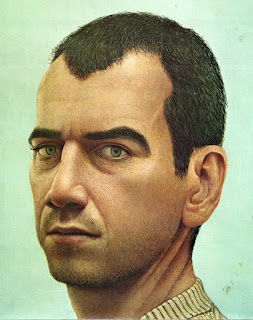 |
| Nope |
This I was happier with. The awkward synthesis of human/tiger was intentional, although I'm not sure it looks that way. New discoveries were made as far as the possibilities of spit-shading. worked more into it and I'm happy with the result, especially the hair on the tiger part.
This I attempted to wrap in casing. After coating it 3 times with matte medium, I began to lay the casing as I had on the previous boxes.
******* Since I had realized while making previous boxes of the salmonella threat, I also used casings that were pre-soaked in bleach and anti-bacterial soap.*********
After laying a few over the painting.....the paint started to separate and bleed. At this point I liked this painting, so I pulled casings off and was able to save it. I may need to soak the bleach more out of the casing, and put more coats of finish on the painting, however I took a break from it at this point: FAIL, more or less.
I decided to paint a more involved composition of taxiderm-ied people, so I started this:
After the ddddrrrrraaaawwwwwiiiinnnngggg exhibit I saw in Raleigh At the Contemporary Art Museum and looking at works of Amy Cutler and Marcel Dzama, as well as others in Vitamin D: New Perspectives in Drawing, I began to think I was possibly akin to drawing more than painting, as I presented in my 'Residence Summary', as well as the reasons why. I thought that is where spit-shading could situate, especially since like drawing, spit-shading is a pre-production technique, leading to tattoo.
I went to the first mentor meeting with Gary Bolding with this in mind. I felt I had a little more direction than where my brain was right after residency, but still something felt a bit unresolved.
One of the reasons I wanted a mentorship with Gary was because of his masterful technique as a figurative oil painter as well as the sometimes odd subjects he paints.
The meeting was completely helpful. I went away from it with a more tangible plan of what I need to work on for the first semester (the nit and grit of the work). We discussed the investigation of skin and obsessiveness the artist has with it and how that can relate conceptually to tattooing. He pointed out my technical shortcomings even considering the fantastical absurdity of some figures. He mentioned early works of Lucien Freud and more-so the work of Gregory Gillespie. As well as his contemporary William Beckman.
Of the pieces I had brought to the residency, he concentrated on one I had completely hated post residency.
When I showed this at residency it had had a sheet of frosted plexiglass suspended over it which obscured the painting. When I showed it to Gary, it was like this, no plexiglass. He pointed out the successes with skin texture, as well as failures of anatomy (eyes, nose).
Gary also confirmed I was a painter, that what I was doing with spit-shading qualified. This was important to hear as I had considered the possibility I was more making marks closer to what artists in drawing movements are doing. This redirected my association to my work, which was reiterated after looking at Gregory Gillespie's work. Maybe spit-shading is neither, both ....I'm not sure it matters to label it, but as I develop the technique more it helps to understand it in a way that will help direct how I work.
Gregory Gillespie:
 |
| Self-Portrait On Bed 1973-1974 Oil and Magna on Wood |
 |
| Self-Portrait with Beads and Charkras 1987-1988 Oil and Alkyd on Panel |
 |
| Self-Portrait (Torso) 1975 Oil and Acrylic on Wood Panel |
 |
| Self-Portrait with Banana 2000 Oil on Wood over Photograph |
We also discussed my lack of composition in a lot of my painting. He suggested looking at Philip Pearlstein, as well as Degas, Vermeer.






No comments:
Post a Comment